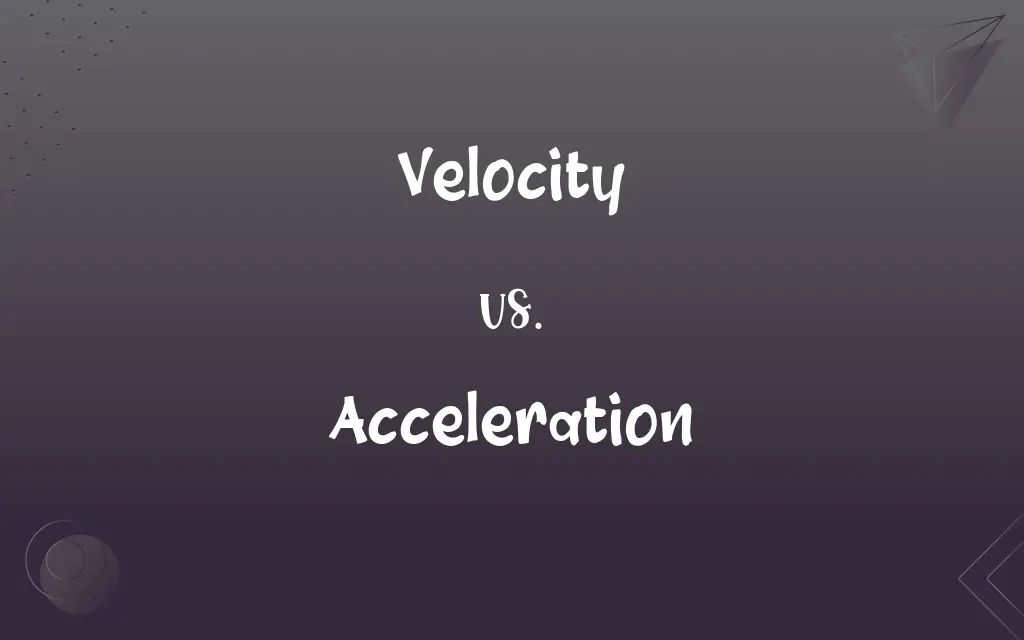Velocity vs. Acceleration: What's the Difference?
Edited by Janet White || By Harlon Moss || Updated on October 23, 2023
Velocity is the speed in a given direction, while acceleration is the rate of change of velocity over time.

Key Differences
Velocity describes the speed of an object in a specific direction, making it a vector quantity. On the other hand, acceleration pertains to how fast or slow the velocity of an object changes over a period of time.
Velocity provides a clear snapshot of an object's movement at any given moment. In contrast, acceleration offers insight into the dynamics of that movement, revealing whether the object is speeding up, slowing down, or changing direction.
It's possible for an object to have a constant velocity, meaning its speed and direction remain unchanged. However, any variation in that velocity implies there's acceleration involved, even if it's just a change in direction without a change in speed.
The units of measurement for velocity typically involve distance over time, such as meters per second (m/s). Acceleration, being a rate of change in velocity, is measured in terms of velocity over time, like meters per second squared (m/s^2).
Velocity can be positive, negative, or zero, indicating direction and magnitude of motion. Acceleration, on the other hand, can be positive (speeding up), negative (slowing down, also known as deceleration), or zero (constant velocity).
ADVERTISEMENT
Comparison Chart
Definition
Speed in a given direction.
Rate of change of velocity.
Type of Quantity
Vector.
Vector.
Representation
Magnitude and direction of motion.
Changes in speed or direction.
Units
Typically meters per second (m/s).
Typically meters per second squared (m/s^2).
Static/Dynamic
Can remain constant.
Indicates a change in motion.
ADVERTISEMENT
Velocity and Acceleration Definitions
Velocity
Rate of change of an object's position.
With a consistent velocity, she completed the marathon in 4 hours.
Acceleration
Change in velocity over time.
The sports car has an impressive acceleration from 0 to 60 mph in 3 seconds.
Velocity
Can be constant or variable.
Despite challenges, the river maintained its velocity downstream.
Acceleration
Can be positive or negative.
Braking leads to negative acceleration or deceleration.
Velocity
Speed in a specific direction.
The car's velocity was 60 mph to the north.
Acceleration
Influenced by external forces.
The acceleration of gravity pulls objects toward Earth.
Velocity
Involves both magnitude and direction.
An object moving at 5 m/s eastward has a specific velocity.
Acceleration
A vector quantity, indicating direction of change.
The acceleration of the roller coaster was felt most during the steep drops.
Velocity
A vector quantity indicating magnitude and direction.
The velocity of the wind shifted from east to west.
Acceleration
Describes dynamics of movement.
The sudden acceleration made passengers grip their seats.
Velocity
Rapidity or speed of motion; swiftness.
Acceleration
The act of accelerating.
FAQs
Can an object have zero velocity but non-zero acceleration?
Yes, like at the topmost point of a thrown object: it has zero velocity but gravity provides acceleration.
Can velocity be negative?
Yes, a negative velocity indicates motion in the opposite reference direction.
Is deceleration the same as negative acceleration?
Yes, deceleration refers to negative acceleration.
How do velocity and acceleration relate to Newton's laws?
Newton's second law connects force, mass, and acceleration, while his first involves objects at rest or constant velocity.
What is velocity in simple terms?
Velocity is the speed of something in a specific direction.
Can you feel acceleration?
Yes, humans can feel changes in acceleration but not constant velocity.
Why is acceleration crucial in car performance?
Acceleration indicates how quickly a car can increase its velocity.
How is acceleration caused in an object?
Acceleration is caused by external forces acting on an object.
Can acceleration occur in space?
Yes, spacecrafts can change their velocity through thrusters, causing acceleration.
What does acceleration indicate?
Acceleration indicates a change in velocity over time.
Can velocity change without acceleration?
No, any change in velocity indicates acceleration.
What's the Earth's acceleration due to gravity?
Approximately 9.81 m/s^2, influencing downward velocity of free-falling objects.
In which scenarios is velocity most observed?
Velocity is observed in anything that moves, from running athletes to orbiting planets.
How do velocity and speed differ?
Velocity has direction, while speed doesn't.
What unit measures acceleration?
Acceleration is typically measured in meters per second squared (m/s^2).
Which one is scalar: speed, velocity, or acceleration?
Speed is scalar; both velocity and acceleration are vectors.
What factors can influence acceleration?
Forces acting on an object can influence its acceleration.
Is velocity relative?
Yes, velocity is often relative to a reference point or observer.
How does direction factor into velocity?
Velocity is a vector, so it must have both magnitude (speed) and direction.
Can an object's velocity be constant?
Yes, if an object maintains the same speed and direction, its velocity is constant.
About Author
Written by
Harlon MossHarlon is a seasoned quality moderator and accomplished content writer for Difference Wiki. An alumnus of the prestigious University of California, he earned his degree in Computer Science. Leveraging his academic background, Harlon brings a meticulous and informed perspective to his work, ensuring content accuracy and excellence.
Edited by
Janet WhiteJanet White has been an esteemed writer and blogger for Difference Wiki. Holding a Master's degree in Science and Medical Journalism from the prestigious Boston University, she has consistently demonstrated her expertise and passion for her field. When she's not immersed in her work, Janet relishes her time exercising, delving into a good book, and cherishing moments with friends and family.































































